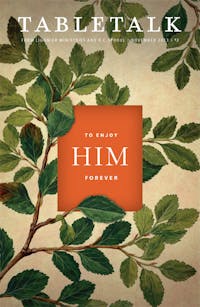
Request your free, three-month trial to Tabletalk magazine. You’ll receive the print issue monthly and gain immediate digital access to decades of archives. This trial is risk-free. No credit card required.
Try Tabletalk NowAlready receive Tabletalk magazine every month?
Verify your email address to gain unlimited access.
The book of Revelation is a visionary tapestry woven from threads drawn from all of Scripture, giving us a unique view into the Lord’s grand purpose for us: to glorify Him and enjoy Him forever. Before we turn to the New Jerusalem passage in Revelation 21:9–22:5, we need to look at two foundational issues.
The first thing to recognize is that Revelation is prophecy (Rev. 1:3; 22:7, 10, 18–19). This means that visions and dreams are to be expected here because symbolic visions are the normal mode of communication through a prophet (see Num. 12:6–8; Ezek. 7:26; Zech. 13:4). This means that John sees visions concerning real things but not the real things themselves. There were no gaunt cows eating fat cows in Joseph’s time (Gen. 41), yet Pharaoh’s dream did represent real, historical matters. So also the visions of Revelation symbolize real things, although their details can be enigmatic even to John (see Rev. 7:13–14).
Second, the phrase “to enjoy Him forever” expresses the covenant bond between our gracious Lord and His people. This bond is expressed over and over in Scripture with the formula “I will be your God, and you will be my people” and its variations (Gen. 17:7–8; Ex. 6:7; Lev. 26:12; Jer. 30:22; 31:1, 33). Sometimes, this bond is simply communicated when the Lord identifies Himself as our God. For example, count how many times “the Lord your God” appears in the Ten Commandments (Ex. 20:1–17). The law comes to us from our God, and we are bound to obey Him because He is our God.
This formula of the covenant bond is a vital element in John’s vision of the new creation in Revelation 21, where we read: “And I heard a loud voice from the throne saying, ‘Behold, the dwelling place of God is with man. He will dwell with them, and they will be his people, and God himself will be with them as their God’·” (v. 3). However, the phrase “they will be his people” in the earliest and best manuscripts actually reads “they will be his peoples” (plural). This phrasing is remarkable and unique, expressing the ultimate fulfillment of God’s covenant promise to Abraham that he will be the father of a multitude of nations (Gen. 17:4–6). These nations appear in Revelation as the Lamb’s people entering the new creation with palm branches as those redeemed by His blood “from every nation, from all tribes and peoples and languages” (Rev. 7:9; see 5:9).
We turn now to John’s vision of the New Jerusalem. It descends from God translucently radiant in jewel-encrusted, golden splendor (21:2, 10–11, 18–21). Yet its most striking feature is its sheer size (v. 16). This “city” measures nearly 1,400 miles long on each side with a footprint of nearly two million square miles. Placed in the center of the United States, such a city would fill about twenty-two states, with borders running from Montana to Wisconsin to Mississippi to Arizona and back to Montana. And the New Jerusalem is also a cube that rises nearly 1,400 miles high (21:16c). To put this in perspective, the International Space Station is currently orbiting earth at an altitude of about 220 miles. The upper stories of the New Jerusalem stretch far beyond the space station into space and stand as a gargantuan contrast with the Jerusalem of John’s day. The New Jerusalem is enormous and perfect (that is, cubic) as the ultimate work of God in the new creation.
As mentioned earlier, John is not seeing and describing an actual physical city, but his vision of it, because the New Jerusalem in this vision actually represents the people of God. She is the bride, the wife of the Lamb prepared for her wedding celebration (21:2, 9; see 19:6– 9). Her gates and foundation stones bear the names of the twelve tribes and the twelve Apostles (21:12, 14), showing that finally the church of the Old and New Testaments will be united together to see God (22:4; see Matt. 5:8; 1 John 3:2). And then God will be her God and she will be His peoples drawn from the four corners of the earth to be invested with God’s glory (Rev. 21:11, 23; see 1:6) and to enjoy Him forever.
